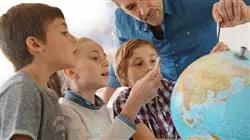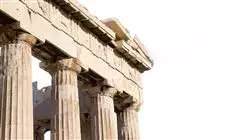University certificate
The world's largest faculty of education”
Introduction to the Program
An innovative and multidisciplinary program that will help you reinvent your Geography and History classes in Primary School in a 100% online format”

In a letter written in 2002 to call for free, quality, basic academic assistance for all children, Nelson Mandela said: "Education is the most powerful weapon you can use to change the world." And so it is. Education creates culture and knowledge, transmits values and generates interest in future doctors, engineers, lawyers, designers, artists, etc. Therefore, professionals in education play a fundamental role in the development of society and must therefore be prepared to assume the responsibility that this entails in an effective and guaranteed manner.
To meet the demands of the current academic environment in Primary School, which includes innovative designs and comprehensive teaching units, TECH has created this Professional program in Teaching Geography and History in Primary School. It is an academic experience that will raise teacher knowledge to the highest level through the most effective educational strategies available today.
To do so, they will benefit from 1,500 hours of diverse material, so as to work on aspects such as elaborating teaching projects, designing recreational activities related to these subjects and implementing ICT in the classroom. Special emphasis will be placed also on developing values such as companionship, equality and solidarity through games and dynamic and entertaining exercises for children between 6 and 12 years of age.
Thanks to this, you will perfect your skills as a teaching professional in just 12 months and 100% online. TECH designs all its programs so graduates do not have to comply with face-to-face classes or restricted schedules; instead, it offers tailored academic experiences through a Virtual Campus that is compatible with any device with an Internet connection, so those on the program can decide when and where to connect.
You will benefit from 1,500 hours of diverse material, including didactic content you can then use in the classroom”
This Professional master’s degree in Teaching Geography and History in Primary School contains the most complete and up-to-date educational program on the market. The most important features include:
- Practical cases presented by experts in Education and the Humanities
- The graphic, schematic, and practical contents with which they are created, provide practical information on the disciplines that are essential for professional practice
- Practical exercises where the self-assessment process can be carried out to improve learning
- Its special emphasis on innovative methodologies
- Theoretical lessons, questions to the expert, debate forums on controversial topics, and individual reflection assignments
- Content that is accessible from any fixed or portable device with an Internet connection
An academic experience without schedules or on-site classes that you can access from any device with an Internet connection”
The program’s teaching staff includes professionals from the field who contribute their work experience to this educational program, as well as renowned specialists from leading societies and prestigious universities.
The multimedia content, developed with the latest educational technology, will provide the professional with situated and contextual learning, i.e., a simulated environment that will provide immersive education programmed to learn in real situations.
This program is designed around Problem-Based Learning, whereby the professional must try to solve the different professional practice situations that arise during the academic year For this purpose, the students will be assisted by an innovative interactive video system created by renowned and experienced experts.
You will work on the design of entertaining and attractive teaching units, which will immerse your students in history in a dynamic way”

Learn how to sustainably manage water catchment and water resources to contribute to the progress of humanity"
Why study at TECH?
TECH is the world’s largest online university. With an impressive catalog of more than 14,000 university programs available in 11 languages, it is positioned as a leader in employability, with a 99% job placement rate. In addition, it relies on an enormous faculty of more than 6,000 professors of the highest international renown.

Study at the world's largest online university and guarantee your professional success. The future starts at TECH”
The world’s best online university according to FORBES
The prestigious Forbes magazine, specialized in business and finance, has highlighted TECH as “the world's best online university” This is what they have recently stated in an article in their digital edition in which they echo the success story of this institution, “thanks to the academic offer it provides, the selection of its teaching staff, and an innovative learning method aimed at educating the professionals of the future”
A revolutionary study method, a cutting-edge faculty and a practical focus: the key to TECH's success.
The most complete study plans on the university scene
TECH offers the most complete study plans on the university scene, with syllabuses that cover fundamental concepts and, at the same time, the main scientific advances in their specific scientific areas. In addition, these programs are continuously being updated to guarantee students the academic vanguard and the most in-demand professional skills. In this way, the university's qualifications provide its graduates with a significant advantage to propel their careers to success.
TECH offers the most comprehensive and intensive study plans on the current university scene.
A world-class teaching staff
TECH's teaching staff is made up of more than 6,000 professors with the highest international recognition. Professors, researchers and top executives of multinational companies, including Isaiah Covington, performance coach of the Boston Celtics; Magda Romanska, principal investigator at Harvard MetaLAB; Ignacio Wistumba, chairman of the department of translational molecular pathology at MD Anderson Cancer Center; and D.W. Pine, creative director of TIME magazine, among others.
Internationally renowned experts, specialized in different branches of Health, Technology, Communication and Business, form part of the TECH faculty.
A unique learning method
TECH is the first university to use Relearning in all its programs. It is the best online learning methodology, accredited with international teaching quality certifications, provided by prestigious educational agencies. In addition, this disruptive educational model is complemented with the “Case Method”, thereby setting up a unique online teaching strategy. Innovative teaching resources are also implemented, including detailed videos, infographics and interactive summaries.
TECH combines Relearning and the Case Method in all its university programs to guarantee excellent theoretical and practical learning, studying whenever and wherever you want.
The world's largest online university
TECH is the world’s largest online university. We are the largest educational institution, with the best and widest online educational catalog, one hundred percent online and covering the vast majority of areas of knowledge. We offer a large selection of our own degrees and accredited online undergraduate and postgraduate degrees. In total, more than 14,000 university degrees, in eleven different languages, make us the largest educational largest in the world.
TECH has the world's most extensive catalog of academic and official programs, available in more than 11 languages.
Google Premier Partner
The American technology giant has awarded TECH the Google Google Premier Partner badge. This award, which is only available to 3% of the world's companies, highlights the efficient, flexible and tailored experience that this university provides to students. The recognition as a Google Premier Partner not only accredits the maximum rigor, performance and investment in TECH's digital infrastructures, but also places this university as one of the world's leading technology companies.
Google has positioned TECH in the top 3% of the world's most important technology companies by awarding it its Google Premier Partner badge.
The official online university of the NBA
TECH is the official online university of the NBA. Thanks to our agreement with the biggest league in basketball, we offer our students exclusive university programs, as well as a wide variety of educational resources focused on the business of the league and other areas of the sports industry. Each program is made up of a uniquely designed syllabus and features exceptional guest hosts: professionals with a distinguished sports background who will offer their expertise on the most relevant topics.
TECH has been selected by the NBA, the world's top basketball league, as its official online university.
The top-rated university by its students
Students have positioned TECH as the world's top-rated university on the main review websites, with a highest rating of 4.9 out of 5, obtained from more than 1,000 reviews. These results consolidate TECH as the benchmark university institution at an international level, reflecting the excellence and positive impact of its educational model.” reflecting the excellence and positive impact of its educational model.”
TECH is the world’s top-rated university by its students.
Leaders in employability
TECH has managed to become the leading university in employability. 99% of its students obtain jobs in the academic field they have studied, within one year of completing any of the university's programs. A similar number achieve immediate career enhancement. All this thanks to a study methodology that bases its effectiveness on the acquisition of practical skills, which are absolutely necessary for professional development.
99% of TECH graduates find a job within a year of completing their studies.
Professional Master's Degree in Teaching Geography and History in Primary School
The situational study of societies, the understanding of immediate contexts and the reflection on the paths that the future may take are indispensable aspects to promote the integral development of children's thinking, since it is through these that they learn to live collectively. In order to fulfill this academic objective, TECH Global University has created a program specialized in historical-geographical education, in the limitations it presents in current curricula and in its formative potential to approach reality. Throughout the 12 months that this program demands, the faculty will address the epistemological and didactic foundations that directly influence the way in which the lessons of these subjects are taught. Consequently, through the appropriate use of technologies, they will review the most pertinent ways to plan classroom and extracurricular activities, taking into account materials, techniques, estimated times and the degree of accessibility of the contents. In this way, they will manage to design entire teaching units, where students will find the necessary educational justifications to dimension the importance of the topics presented.
Professional Master's Degree in Teaching Geography and History in Primary School
By taking this postgraduate degree offered by TECH, professionals in the field of education will have the opportunity to strengthen their skills in the academic preparation of children in these two disciplines. Thanks to the theoretical and practical program offered in the syllabus, they will have the necessary tools to develop each of the aspects that make up the analytical-comparative competencies of their students. All this, through the discussion of original reasoning around cultural heritage and the basic material for relational reflection between spaces or times. Based on this type of dynamics, teachers will be able to work with confidence in different educational environments, taking as a starting and finishing point the application of pedagogical models that place special emphasis on "teaching to think" both in the past and in the present. At the end of the program, they will be able to find new ways of transmitting knowledge, making use of the game as a socializing tool and transmitter of knowledge, ideas and values.







